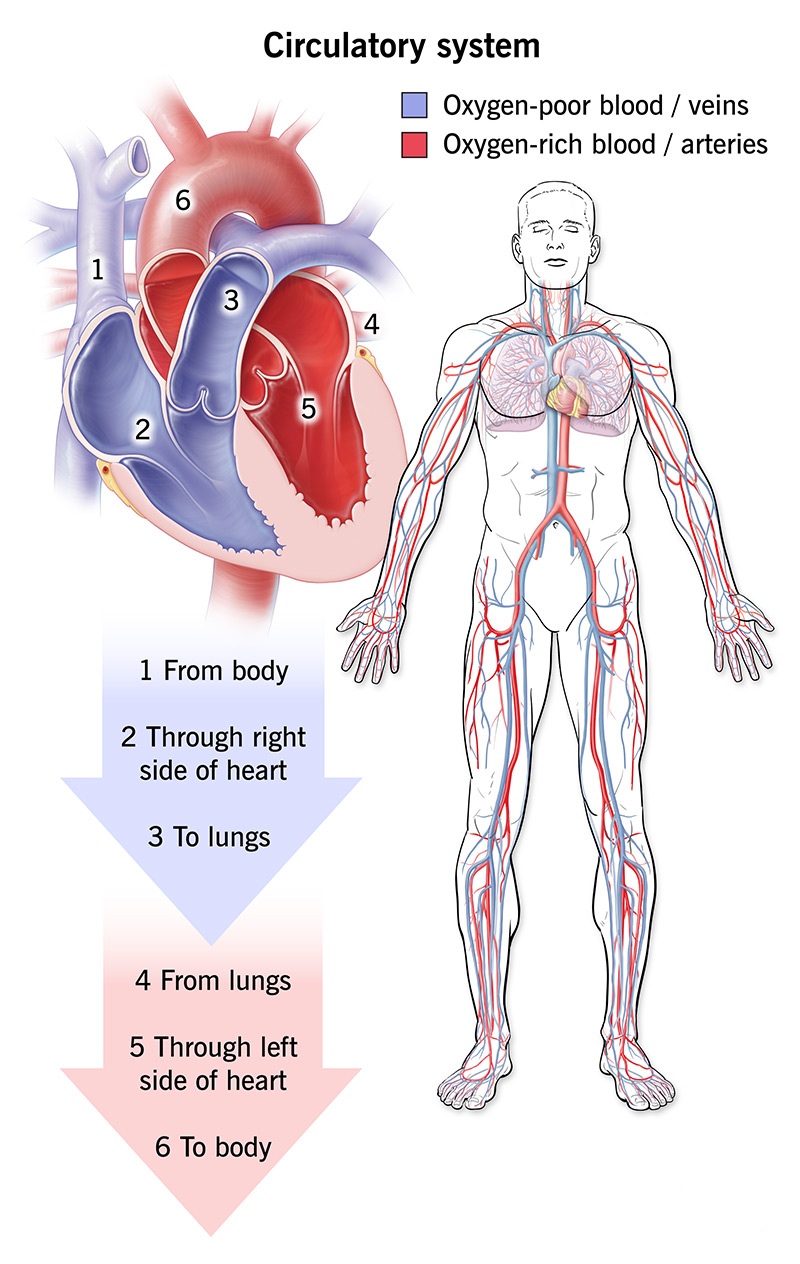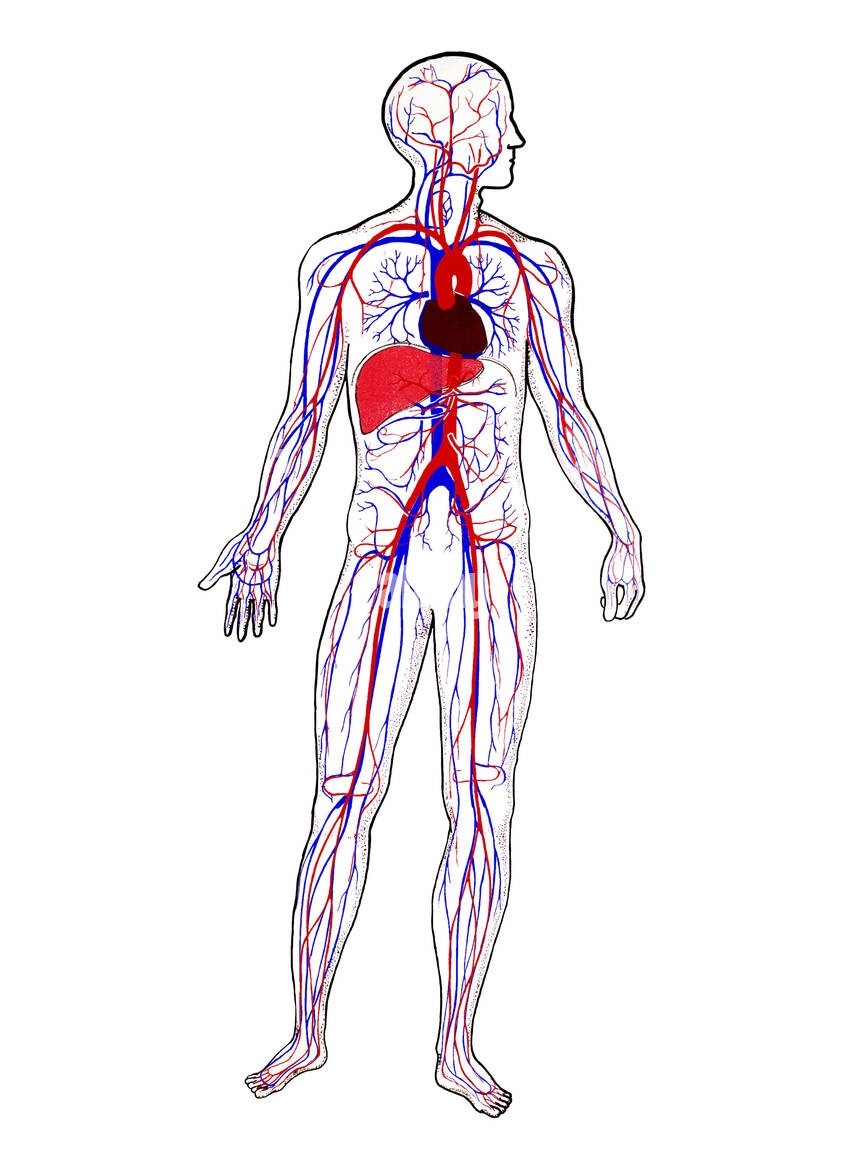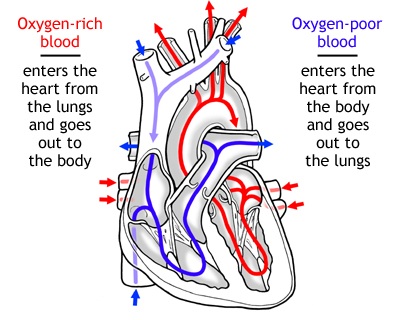Human Circulatory System: Organs, Diagrams, It's Functions
The circulatory system is a very important part of the human body. It moves nutrients and oxygen to the cells and takes away waste. The main parts of the circulatory system are the heart, blood, and blood vessels. Let's learn what the system is, the organs involved, and how they work together.
What is the Circulatory System?
The circulatory system (or cardiovascular system) is the internal transport system of the body. It circulates blood throughout the body, providing oxygen and nutrients to tissues and organs & carrying away metabolic waste products, including carbon dioxide.
Circulatory System Anatomy & Physiology

Image Source: Cleveland Clinic
Blood
Blood is essentially a red liquid that is a transport medium for whatever biology requires. An adult human body has about 5 liters of blood. It consists of:
Plasma: It is the pale yellowish liquid part of blood, which makes up about 55% of blood. The straw-colored fluid, called plasma, carries water, proteins & waste.
Blood Cells:
-
Red Blood Cells (RBC): Red blood cells have haemoglobin that binds to oxygen & gives blood its red colour. They’re bigger than RBCs but combat infection.
-
White Blood Cells (WBCs): A little bigger than RBCs, these fight infections.
Heart
The heart is a muscular structure in the center of the chest, slightly left of center. About the size of a clenched fist, it serves as a pump that circulates blood through the body. The heart provides the functional force between all blood & rest about 60-100 times per minute, which makes the “lub-dub” sound.
Blood Vessels
Blood vessels are blood-filled tubes that help move blood around the body. They are categorised into:
-
Arteries: Carry oxygenated blood away from the heart.
-
Veins: Bring oxygen-poor blood back to the heart.
-
Capillaries: Small vessels that carry oxygen & nutrients to tissues.
Blood Flow in the Human Body

Image Source: Alamy
Blood flows in two circuits:
- Pulmonary Circulation
In pulmonary circulation, the pulmonary arteries transport oxygen-poor blood pumped out of the heart to the lungs. The lungs traded carbon dioxide for oxygen, and that now-oxygenated blood went back to the heart. - Systemic Circulation
The heart then circulates that oxygen-rich blood throughout the body. This is where nutrients get delivered to, and oxygen gets delivered to & waste gets picked up from cells. Oxygen-free blood comes back to the heart at this stage, and the cycle repeats.
Did You Know? In fact, the heart pumps 2,000+ gallons of blood throughout our body every minute—that's enough to fill a large tanker truck.
Components and Functions of Blood
The following table summarizes the components of blood & their functions:
|
Component |
Description |
Function |
|
Plasma |
Pale yellow liquid, 90% water |
Transports nutrients, hormones, & waste |
|
Red Blood Cells |
Disk-shaped cells containing haemoglobin |
Carry oxygen to cells & remove carbon dioxide |
|
White Blood Cells |
Larger, colorless cells |
Protect against infections & diseases |
|
Platelets |
Tiny cell fragments |
Help in clotting to prevent excessive bleeding |
Did You Know? The lifespan of an RBC is about 120 days, while platelets last only 5-9 days.
Blood flow through the Heart

Image Source: Medline Plus
The heart has four chambers:
-
From the body, deoxygenated blood is delivered to the Right Atrium.
-
This blood is then pumped by the Right Ventricle to the lungs.
-
Left Atrium: It collects oxygenated blood from the lungs.
-
The Left Ventricle sends blood with oxygen to the whole body.
The path of blood follows:
-
Veins: Deoxygenated blood enters the right atrium through the veins.
-
From the right ventricle, it is pumped to the lungs.
-
The left atrium receives oxygenated blood from the lungs.
-
It enters the left ventricle, which pumps it to the body.
An athlete may have a heart that is significantly stronger & pumps blood more efficiently, leading to a lower heart rate when at rest.
Different Types of Blood Cells
Red Blood Cells (RBCs)
-
It contains haemoglobin that binds to oxygen
-
Accounts for 40-45% of the blood volume
White Blood Cells (WBCs)
-
Fight like the immune system’s soldiers
-
Defend against bacteria, viruses, etc.
Platelets
-
Essential for blood clotting
-
Stops blood loss during injuries
Importance of the Lungs in Circulation
The blood is oxygenated, so that the lungs are linked to the blood. During inhalation, oxygen comes into the lungs and binds to the haemoglobin of the RBCs. The oxygen-rich blood is then delivered to the heart & pumped to the whole body.
Maintaining a Healthy Heart
To keep the circulatory system in good working order, maintain the following habits:
-
Exercise frequently: Swimming, cycling, or walking strengthens cardiovascular system
-
Healthy eating: Eat fruits, vegetables, & whole grains.
-
Don’t smoke: It harms blood vessels & the heart.
-
Stay Hydrated: Staying well-hydrated helps blood circulate.
Fun Facts about the Circulatory System
-
Your blood circulates approximately 19,000 km per day.
-
RBCs travel through them in a single file since capillaries are so small.
-
That sound of your heartbeat is the valves of your heart opening & closing.
Things you have learned!
- Learned how the circulatory system helps bring oxygen and nutrients to the body and remove waste.
- Found out how the heart, blood, and blood vessels work together to keep the body alive.
- Understood how blood moves through the body and what each part of the blood does.
- Learned how being active helps the heart and blood system work well.











